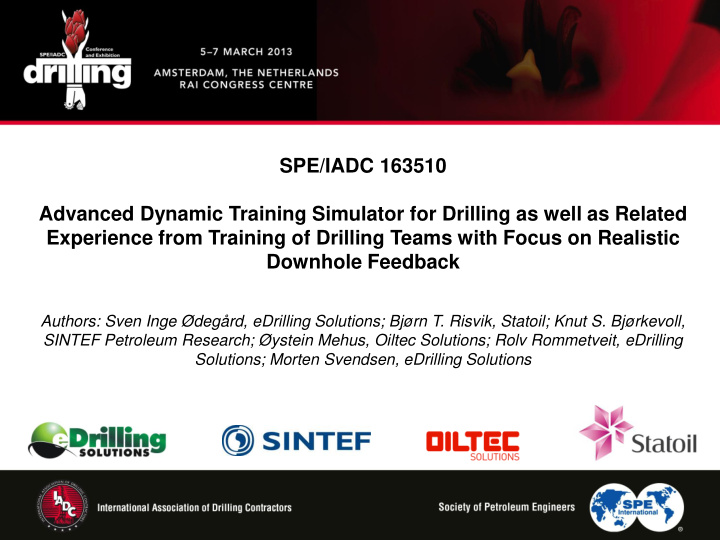



SPE/IADC 163510 Advanced Dynamic Training Simulator for Drilling as well as Related Experience from Training of Drilling Teams with Focus on Realistic Downhole Feedback Authors: Sven Inge Ødegård, eDrilling Solutions; Bjørn T. Risvik, Statoil; Knut S. Bjørkevoll, SINTEF Petroleum Research; Øystein Mehus, Oiltec Solutions; Rolv Rommetveit, eDrilling Solutions; Morten Svendsen, eDrilling Solutions
Content • Background – Market – Technology • Simulator capabilities – Top-side – Dynamic down-hole • Operations – HPHT, TTRD, ERD, MPD • Future perspective • Drilling simultor training – Application – Experience
Background • Market – Not available in 2010 – Customer encourage suppliers to cooperate • Technology – Dynamic models verified RealTime in MPD and Decision support systems – State of the Art Topside Drilling equipment simulator
Downhole • Advanced integrated hydraulics and temperature model − Realistic transient calculations − Realistic dynamic effects − Multi-phase capabilities • Realistic gas behavior in oil- and water based muds • Dynamic torque and drag calculations integrated with topside simulator − Realistic feedback from draw works and top drive • ROP model for realistic WOB = Realistic feedback from virtual well
Topside • Modern offshore drilling rig containing standard generic equipment that can be configured to operate like an actual rig’s equipment • Drawworks • Heave compensator • Topdrive • Iron Roughneck • Mud pumps • Active mud system • Pipe handling machinery including racking machine and fingerboard • Trip tank system (pump and tank) • Valves, suface lines, kelly line, slip-joint, Chokes, BOP, etc
Simulator configuration • Topside − Surface lines − Valves − Pumps − Tanks and fluids − BOP stack − Chokes − Fluid properties • Downhole − Drill string and BHA components − Well path − Formation properties − Formation “Hardness” − Reservoirs − Loss zones
Simulator infrastructure Topside simulator T/D Flow Model w/ model ROP (P, T)
Simulator infrastructure 3D 2D plot clients Instructor Top side Top side clients Virtual client Top side Top side 3D viz. 3D viz. well 3D viz. 3D viz. Top side Downhole Simulator Simulator Hub T/D Top side HMI HMI HMI HMI HMI Model Flow 3D viz. clients clients clients clients w/ ROP clients Model
User interface
Operations The dynamic training simulator will enable realistic training on the following: • Drilling and tripping operations • Stripping operations • Connections • Multi fluid operations • Well control (kick and losses) • TTRD (Through Tubing Rotary Drilling) • MPD (Managed Pressure Drilling) • HPHT (High Pressure High Temperature) • ERD (Extended Reach Drilling) Relavent feedback from well in all operations due to dynamic response…….
MPD training • Complex operation • Sub contractors • Procedure testing • Extra equipment – MPD choke – Backpressure pump • Testing 3rd part control system • Experience – Improvement on 3rd part system due to new challenging TTRD configuration
Future perspective • Education/learning • Customize for Drill Well On Paper Exercises • Test and train on new drilling methods/concepts • Seamless integration with RealTime operation • Use Simulator models and virtual well as a planning / design verification tool. (Coupling T/D, hydraulics & temperatures in one system)
Training Philosophy Statoil's ambition is to raise company-wide performance and thus reduce the likelihood of loss due to deficient quality and precision in our activities. Our objectives are thus improved risk handling , more effective work processes and continued development of leadership skills in order to provide the foundations for a value-based performance culture. To ensure quality in all aspects of Statoil’s activities, we have decided to introduce a generic work form for use in all delivery processes. The Compliance & Leadership model This model applies to any task and is the way we work in Statoil, also when performing training at the Drilling Simulator.
Drilling Simulator Training The goal is to provide realistic team training on common and critical drilling and well operations according to the Compliance and Leadership model.
Training Preparations PROJECT DEFINED CHALLENGES SIMULATOR CAPABILITIES Pore Pressure ramp Geological uncertainty Fracture/Loss/Ballooning Collapse / Pack-off Small operational window CONFIGURATION Underground blow-out Operational procedures Contingency procedures Emergency systems
Application
Experience DW100 – Well Construction Process BENEFITS FROM THE SIMULATOR Verification of plans and procedures. Enhanced risk assessment and planning. Focus areas Task Focus on down-hole conditions and limitations, Contingencies Design including key drilling parameters and best practices. Verification of Plans Realistic application of skills and competence. Competence Application of procedures Limitations Confidence with critical events and well control situations. Handling of defined hazards Emergency systems Hazards Team approach to handling of well specific challenges (CRM). Communication Verification of emergency systems and relevant procedures. Procedures Understanding of the Compliance and Leadership model. A team that is better prepared to execute tasks, handle critical situations and to ensure safe and efficient drilling operations
Slide 18 Thank you for the attention, any questions?
Recommend
More recommend